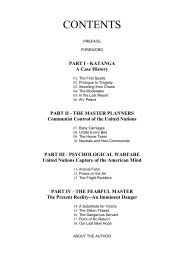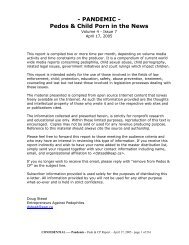En Route to Global Occupation .pdf - Equal Parenting-BC
En Route to Global Occupation .pdf - Equal Parenting-BC
En Route to Global Occupation .pdf - Equal Parenting-BC
Create successful ePaper yourself
Turn your PDF publications into a flip-book with our unique Google optimized e-Paper software.
58 <strong>En</strong> <strong>Route</strong> <strong>to</strong> <strong>Global</strong> <strong>Occupation</strong><br />
ditional newspapers all around the country.<br />
Major magazines in the CFR orbit include: Fortune, Time, Life,<br />
Money, People, and Sports Illustrated (all of which are under the<br />
umbrella of Time, Inc.), Newsweek, Business Week, U.S. News &<br />
World Report, Saturday Review, Reader's Digest, Atlantic Monthly,<br />
McCall's, and Harper's Magazine.<br />
These publications have aJso been influenced by a growing number<br />
of establishment banks and corporations whose advertisements<br />
generate huge revenues for the magazines, such as Citicorp, Chase<br />
Manhattan Corporation, Chemical Bank, Bankers Trust New York,<br />
Manufacturers Hanover, Morgan Guaranty, Exxon, Mobi~ Atlantic<br />
Richfield/ ARCO, Texaco, IBM, AT & T, General Electric, Gener~ Mo<strong>to</strong>rs<br />
Corporation, Ford Mo<strong>to</strong>r Company, and Chrysler Corporation.<br />
Rockefeller-owned or -influenced oil companies, banks, and<br />
blue-chip corporations are not the only buyers of advertising space.<br />
One must include in this list the major department s<strong>to</strong>re chains, which<br />
are probably the largest advertisers. R.H. Macy and Company, Federated<br />
Department S<strong>to</strong>res, Gimbel Brothers, Sears, Roebuck and Company,<br />
J.C. Penney Company, the May Department S<strong>to</strong>res Company,<br />
and Allied S<strong>to</strong>res Corporation have all had on the board of direc<strong>to</strong>rs<br />
members of the CFR or partners from the CFR interlocked international<br />
banking firms.6To this list must be added the hundreds of additional<br />
corporations directly owned by the Rockefeller banks, oil companies,<br />
and foundations who must also put their advertising money<br />
somewhere.<br />
Along with controlling the major networks, newspapers, and<br />
magazines, the Rockefeller establishment has a lock on book publishing<br />
as well. The following publishers have been represented on the<br />
Council on Foreign Relations: MacMillan, Random House, Simon &<br />
Schuster, McGraw-Hill, Harper Brothers, ffiM Publishing and Printing,<br />
Xerox Corp., Yale University Press, Little Brown and Company, Viking<br />
Press, Cowles Publishing, and Harper and Row. Many of these<br />
specialize in publishing textbooks-which brings us <strong>to</strong> an important<br />
point<br />
If the mass communication industry is dominated by individuals<br />
and organizations committed <strong>to</strong> the advancement of global government<br />
then the only public medium left <strong>to</strong> warn us about this<br />
danger i~ public education. But how can this be accomplished if the<br />
major textbook publishers are owned or influenced by establishment<br />
insiders<br />
Discovering this hidden influence prompted me <strong>to</strong> take a closer<br />
look at the field of public education <strong>to</strong> see what the establishment<br />
America's Shadow Government 59<br />
was up <strong>to</strong> there. What I discovered was even more disillusioning than<br />
the situation concerning the media. Although I knew that public education<br />
was going through troubled times, I didn't realize that much<br />
of this was due <strong>to</strong> the fact that it was one of the first areas targeted<br />
for subversion. I finally understand why our schools are such a mess.<br />
Using Publlc Education<br />
John D. Rockefeller made his first move on education in 1902<br />
when he formed the General Education Board (GEB). 7 To ensure control<br />
of this tax-exempt organization he put his assistant, Frederick T.<br />
Gates, in charge as chairman. 8 Gates revealed the Rockefeller philosophy<br />
on education in the board's "Occasional Letter, No.1."<br />
In our dreams we have limitless resources and the<br />
people yield themselves with perfect docility <strong>to</strong> our<br />
moulding hands. The present educational conventions<br />
fade from our minds, and unhampered by tradition, we<br />
work our own good will upon a grateful and responsive<br />
rural folk.9<br />
The General Education Board would later expand its activities<br />
<strong>to</strong> include the city folk as well<br />
Between 1902 and 1907, John, Sr., would give a <strong>to</strong>tal of $43<br />
million <strong>to</strong> the GEB. And from 1917 <strong>to</strong> 1919 he and his son,John D.,<br />
Jr., gave a combined <strong>to</strong>tal of $200 million <strong>to</strong> the GEB, the Rockefeller<br />
Foundation, and the Laura Spelman Rockefeller Memorial. 10 The <strong>to</strong>tal<br />
amount of Rockefeller funds given <strong>to</strong> influence education from<br />
1902 <strong>to</strong> 1930, in <strong>to</strong>day's money, would be equivalent <strong>to</strong> more than<br />
$2 billion. This is an incredible sum of money going <strong>to</strong> promote<br />
globalism and socialism within education, particularly when one considers<br />
that there was little, if any, foundation-sponsored opposition<br />
during this same period of time.<br />
According <strong>to</strong> Gary Allen, who wrote '/be Rockefeller File,<br />
the foundations (principally Carnegie and Rockefeller)<br />
stimulated two-thirds of the <strong>to</strong>tal endowment funding<br />
of all institutions of higher learning in America during<br />
the first third of this century. During this period the<br />
Carnegie-Rockefeller complex supplied twenty percent<br />
of the <strong>to</strong>tal income of colleges and universities and<br />
became in fact, if not in name, a sort of U.S. Ministry of<br />
Education. 11<br />
(It should be noted that the Rockefeller and Carnegie foundations<br />
often had interlocking direc<strong>to</strong>rates and frequently acted in unison.<br />
This is still the case <strong>to</strong>day.)<br />
These same foundations began in the early thirties <strong>to</strong> back john



![Robert T McQuaid [rtmq@stn.net] Sent: Friday, October 29, 2004 12 ...](https://img.yumpu.com/51070071/1/190x245/robert-t-mcquaid-rtmqstnnet-sent-friday-october-29-2004-12-.jpg?quality=85)







